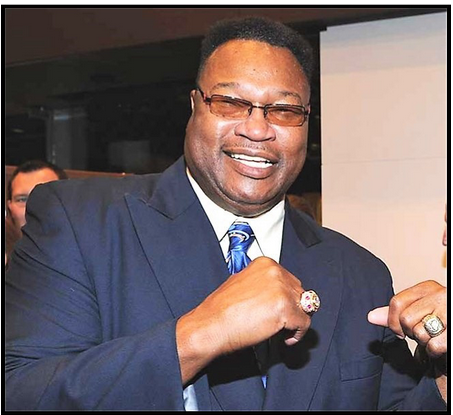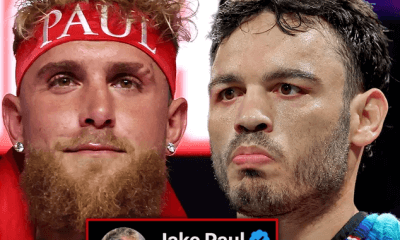Featured Articles
Larry Holmes Challenged Me to a Fight (I Declined)

Larry Holmes Challenged Me to a Fight (I Declined)
“Mama always said, life was like a box of chocolates. You never know what you’re gonna get,” said the Tom Hanks character Forrest Gump in the movie of the same name. I always think of that famous line when I pop into a local boxing gym and chance upon an interesting person I had never formally met and never expected to find there. It actually happens quite frequently. For a boxing writer, it’s one of the nice little perks about living in Las Vegas.
The Bones Adams gym is the closest gym to my house. I could walk there, if need be, but prefer to detour there on one of my daily bicycle rides. The gym sits deep behind an iron gate that is almost always locked, but for those that are privy to the entrance code it is the most welcoming gym in the city.
I popped in yesterday afternoon and who should I find there but none other than Larry Holmes. He was there at the behest of Don King and King’s chief lieutenant Stacey McKinley to size up Trevor Bryan who defends his WBA secondary heavyweight title against Daniel Dubois on June 11.
“No cheering in the press box” is the admonition that is writ large in the canon of sports journalism. In other words, don’t get emotionally attached to the athletes that you cover. But that’s easier said than done and my favorite boxer of all time is Larry Holmes.
Larry Holmes turned pro in 1973 at age twenty-three and captured the world heavyweight title five years later with a razor-thin decision over Ken Norton. He needed a big 15th round to pull that fight out of the fire and the expectation was that his reign would be brief, but he fooled us; he just kept winning and winning. Holmes’ final record, 69-6, included a 21-6 mark in bouts sanctioned as world title fights. The first two of those six setbacks, coming at the hands of Michael Spinks after Larry had advanced his record to 49-0, were controversial.
Larry Holmes wasn’t flashy in the ring; he was methodical. To say he was my favorite boxer misses the point. He was my favorite ring personality; the person that I most admired among those that happened to box and do it well.
When I first started covering boxing, I was very conscious of the fact that I wasn’t in the same league as the reporters from the major metropolitan dailies. I was deemed worthy of a press badge only because the PR people at the hotels took care of the local guys and I was a local guy with a small footprint in radio and in one of the weekly rags.
The fighters at the top of the food chain had their own PR people who culled the herd, so to speak, giving a small cadre of “A list” writers access to their clients in settings more intimate than a formal press conference. The fighters themselves came to know which members of the media were most useful to them and acted accordingly.
And that is why I became a big fan of Larry Holmes. He didn’t compartmentalize; he treated everyone the same. He wanted to vent after his first fight with Spinks and invited everyone crowding around him up to his suite in the Riviera Hotel. In that cramped space we were all “A list” guys.
As is common with folks in other lines of work, boxers tend to change when the money starts rolling in and they become increasingly more well-known. In the vernacular of old friends left behind, they start to put on airs.
Larry Holmes never changed. He could have purchased a mansion in Beverly Hills and hobnobbed with the Hollywood elite, but after each fight he returned to Easton, an old industrial town in Pennsylvania’s Lehigh Valley where the workforce is still primarily blue-collar. Throughout his long career there was never a whiff of scandal.
Larry Holmes didn’t have his clothes customized by a tailor on Rodeo Drive. The duds he wore yesterday – well-worn blue jeans, a short-sleeved shirt, a ball cap – were of the sort a man would wear on a tractor. There were two fancy rings on his fingers but otherwise no bling.
Inside Bones Adams’ gym, Holmes moved at a slow gait; almost, but not quite, shuffling. Every boxing gym has a full-length mirror where preening boxers shadow-box, and there was a precious moment when Holmes stood before it, peppering an invisible opponent with his inerrant jab, his signature punch.
It had been many years since I last talked with Larry Holmes. It was a call-in interview arranged by the producer of our radio talk show. Larry was in a happy mood that night. The Easton Police Department had just leased one of the buildings that he owned. “I believe I’m the only black guy in the country that owns a police station,” he said.
Holmes was in a convivial mood again yesterday and I’m happy to report that although his gait was slow, his mind was clear. There was nothing in the words that came out of his mouth that betrayed a hint of incipient dementia. He could re-visit old fights with vivid recall, a marvel considering that he answered the bell for 579 rounds during the course of those 75 pro fights while trading blows with some of the biggest punchers of his era.
“I must be older than you,” he said after we made eye contact. I corrected him: “No, I’m older than you.”
“Well,” he said, “one of us has to be right and I know how we can settle it.” He gestured toward the door, a mischievous look in his eye.
One of the quotes ascribed to Larry Holmes was a line about Don King: “I knew he was ripping me off, but I also knew I wouldn’t have made more money with any other promoter.” Holmes says he never said it; a reporter was taking liberties. “Sure, Don and I had our differences, but I have my differences with her too,” he said, playfully nudging his wife Diane, the pleasant woman seated on his left scrolling through her iPad. “If I could have made more money with someone else, why didn’t they come and see me?”
Holmes was pleased when I reminded him that his 1982 bout with Gerry Cooney – we’re approaching the fortieth anniversary – still holds the record for the largest attendance at a boxing event in Nevada. A crowd of 30,000-plus (29,214 paid) that included an international press contingent of eight hundred, squeezed into the makeshift outdoor arena at Caesars Palace to witness the conflagration.
“What I remember is that everyone there was rooting for Cooney,” he said, which wasn’t that far from the truth. When I told him that I wasn’t one of those cheering for Cooney because I had bet against the lantern-jawed Irishman, he said, “Where’s my cut?” while extending his open palm.
The fight, which lasted into the thirteenth round, ended when Cooney’s trainer Victor Valle bounded into the ring to save his man from taking any more punishment. The bout was tight on the scorecards through the completed rounds notwithstanding the fact that Cooney had three points deducted from his score for low blows. After the bout, Holmes said, “Gerry was in my pants so often tonight that I thought he wanted to marry me.”
The fight was fought against a sinister shadow. In their pre-fight screeds, some pundits contorted the match into the reincarnation of the 1910 bout between Jack Johnson and James J. Jeffries that stoked the flames of racial discord, America’s first Fight of the Century. The Cooney camp took pains to downplay the racial subplot which only made it louder.
It’s common knowledge that Larry Holmes and Gerry Cooney have become fast friends. “I see Gerry a lot,” he says, noting that they will be getting together again early next month at a public appearance in Miami. “Gerry had nothing to do with all that rubbish. He’s a nice guy. But,” he continued impishly, “if he gets out of line, I may have to whip his ass (he paused for dramatic effect)…again!”
As for Trevor Bryan, Holmes, who has five grandchildren and five great-grandchildren, avers that he likes what he sees. “He needs to get more extension on his jab,” he says, “but he’s almost there.”
When Trevor Bryan had finished his workout, Stacey McKinley, his face dripping with sweat, joined our conversation and the talk turned to old fights, old fighters, and old trainers which is what old salts talk about when the subject turns to boxing. McKinley, born in the same year as Larry Holmes, has a bone to pick with Gervonta “Tank” Davis who fights this Saturday in Brooklyn. Davis, who represents Baltimore, has apparently never heard of the immortal Joe Gans, the greatest Baltimore fighter of them all. Young boxers today, laments McKinley, are ignorant of their forefathers. It is a lamentation that has redounded through the generations.
And so, I happened to duck into Bones Adams’ gym on a Wednesday afternoon and found myself shooting the breeze with none other than Larry Holmes. It was as if we were sitting in a barbershop, two guys from the neighborhood chatting about this and that as we awaited our turn in the chair.
Yes, Holmes is still my all-time favorite fighter, but please keep that under your hat. There is to be no cheering in the press box.
To comment on this story in the Fight Forum, CLICK HERE
Arne K. Lang’s latest book, titled “George Dixon, Terry McGovern and the Culture of Boxing in America, 1890-1910,” will shortly roll off the press. The book, published by McFarland, can be pre-ordered directly from the publisher (https://mcfarlandbooks.com/product/clashof-the-little-giants) or via Amazon.
-

 Featured Articles4 weeks ago
Featured Articles4 weeks agoAvila Perspective, Chap. 330: Matchroom in New York plus the Latest on Canelo-Crawford
-

 Featured Articles3 weeks ago
Featured Articles3 weeks agoVito Mielnicki Jr Whitewashes Kamil Gardzielik Before the Home Folks in Newark
-

 Featured Articles21 hours ago
Featured Articles21 hours agoResults and Recaps from New York Where Taylor Edged Serrano Once Again
-

 Featured Articles4 weeks ago
Featured Articles4 weeks agoCatching Up with Clay Moyle Who Talks About His Massive Collection of Boxing Books
-

 Featured Articles5 days ago
Featured Articles5 days agoFrom a Sympathetic Figure to a Pariah: The Travails of Julio Cesar Chavez Jr
-

 Featured Articles3 weeks ago
Featured Articles3 weeks agoMore Medals for Hawaii’s Patricio Family at the USA Boxing Summer Festival
-

 Featured Articles1 week ago
Featured Articles1 week agoCatterall vs Eubank Ends Prematurely; Catterall Wins a Technical Decision
-

 Featured Articles4 weeks ago
Featured Articles4 weeks agoRichardson Hitchins Batters and Stops George Kambosos at Madison Square Garden




















